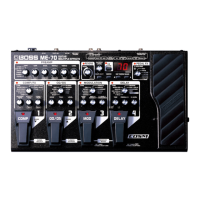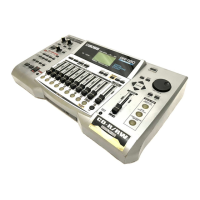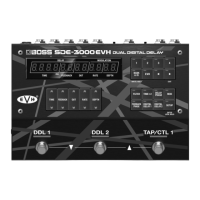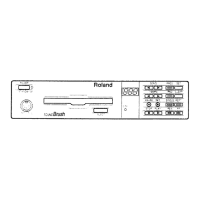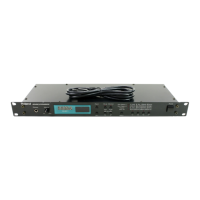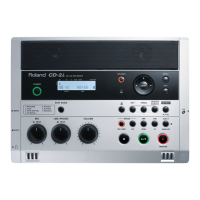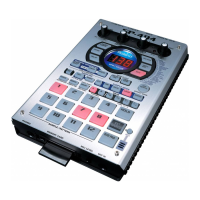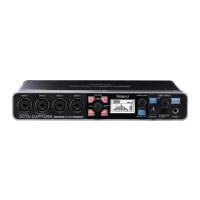22
Mar. 2008 GT-10
14. RETURN
Testing of the RETURN Circuitry and the RETURN
Jack Switch
fig.14return2.eps
1. Using the two cables with 1/4-inch phone plugs, connect the OUTPUT L
and R jacks to channel 1 and channel 2 of the oscilloscope and to the left-
channel and right-channel monitor speakers.
2. Verify that the output waveform display on the oscilloscope is what is
shown in the figure below.
fig.14return.eps
Upper: left channel, lower: right channel
3. Verify that the peak value is from 0.75 to 0.90 V for the left channel and
from 0.60 to 0.70 V for the right channel.
4. Verify that signals are output from the monitor speakers and no noise or
other abnormal sound is heard.
5. Insert a dummy jack (open plug) into the RETURN jack and verify that
the sound and waveform disappear.
6. Press [ ] to advance to the next test.
15. INPUT NOISE
Testing of Residual Noise and Shock at the
Respective Outputs
fig.15inputnoise2.eps
1. Insert a 47-k ohm plug into the INPUT jack.
2. Connect the left channel of the PHONES jack and the noise meter using a
cable with a 1/4-inch stereo phone plug (with 33-ohm load resistor), and
verify that the noise level is -96 dBu or less (DIN audio).
3. Connect the right channel of the PHONES jack and the noise meter using
a cable with a 1/4-inch stereo phone plug (with 33-ohm load resistor),
and verify that the noise level is -96 dBu or less (DIN audio).
4. Connect the OUTPUT L jack and the noise meter using a cable with a 1/4-
inch stereo phone plug, and verify that the noise level is -89 dBu or less
(DIN audio).
5. Connect the OUTPUT R jack and the noise meter using a cable with a 1/
4-inch stereo phone plug, and verify that the noise level is -89 dBu or less
(DIN audio).
6. Using the two cables with 1/4-inch phone plugs, connect the OUTPUT L
and R jacks to the left- and right-channel monitor speakers.
7. Press the [WRITE] button and verify that the Check INPUT Noise
message displayed changes to Check SHOCK Noise.
8. Verify that the noise sound played by the monitor speakers is free of any
problem.
9. Subject the unit to vibration and verify that no abnormal sound is heard
from the speaker.
10. Press [ ] to advance to the next test.
16. LOOP NOISE
Testing of the SEND/RETURN Connection and
RETURN Shock
fig.16loopnoise2.eps
1. Insert a 47-k ohm plug into the INPUT jack.
2. Make sure that nothing is inserted into the RETURN jack.
3. Connect the OUTPUT L jack and the noise meter using a cable with a 1/4-
inch phone plug, and verify that the noise level is -88 dBu or less (DIN
audio).
4. Connect the OUTPUT R jack and the noise meter using a cable with a 1/
4-inch phone plug, and verify that the noise level is -88 dBu or less (DIN
audio).
5. Using the two cables with 1/4-inch phone plugs, connect the OUTPUT L
and R jacks to the left- and right-channel monitor speakers.
6. Press the [WRITE] button and verify that the Check LOOP Noise
message displayed changes to Check SHOCK Noise.
7. Verify that the noise sound played by the monitor speakers is free of any
problem.
8. Subject the unit to vibration and verify that no abnormal sound is heard
from the speakers.
9. Press [ ] to advance to the next test.
17. FACT RESET
Factory Reset
* Unless instructed otherwise, do not execute a Test Mode Factory Reset. Pressing
[EXIT] performs no Factory Reset.
Executing the Factory Reset in the Test Mode (17. FACT RESET) initializes the
threshold value for pedal calibration (to a value of 6). When you have executed
17. FACT RESET, go to 7. INT EXP PEDAL and make the setting for pedal
calibration.
Short Check
Testing of AMP CTRL Insulation
1. Switch off the power.
2. Touch the tester to the ground for the AMP CTRL jack and to the chassis
ground (a screw section on the chassis) and verify that no conduction
occurs.
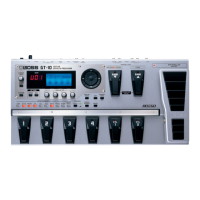
